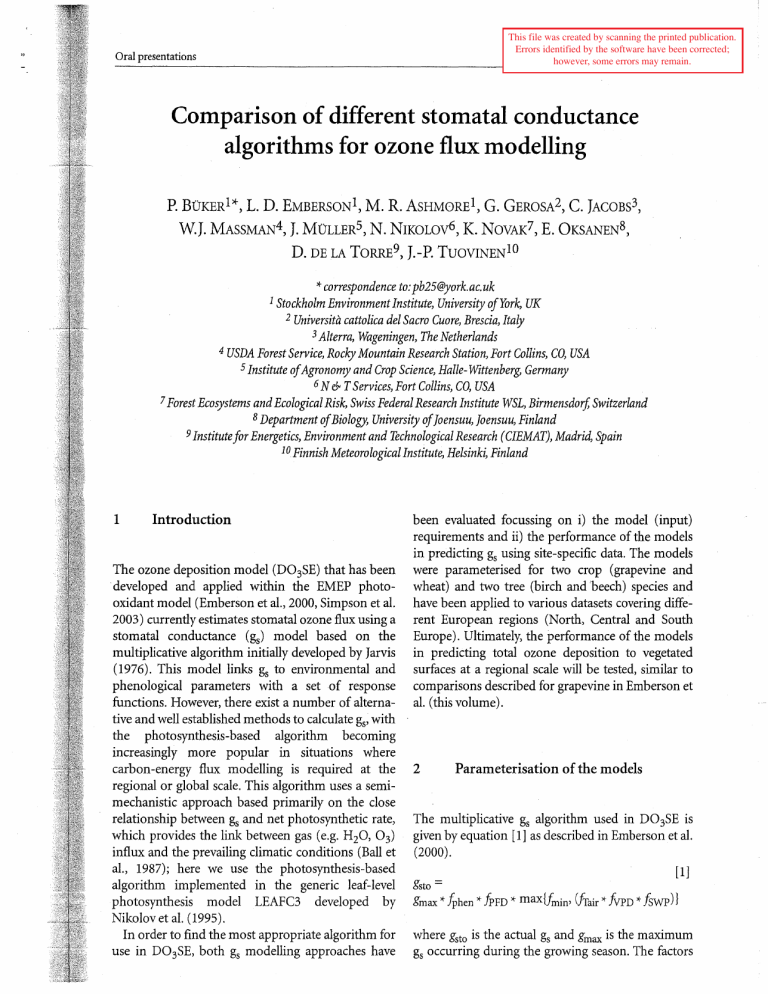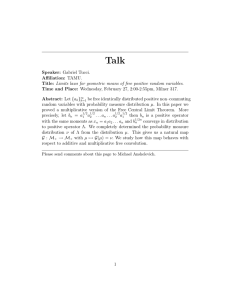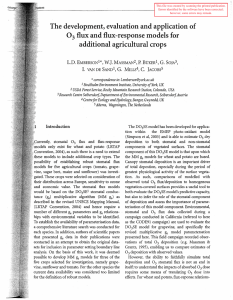Comparison of different stomatal conductance algorithms for ozone flux modelling W.J. J.

Oral presentations
This file was created by scanning the printed publication.
Errors identified by the software have been corrected;
133
Comparison of different stomatal conductance algorithms for ozone flux modelling
P.
BDKERI*,
L. D.
EMBERsoN I, M.
R.
AsHMORE I, G. GEROsA2,
C.
JAcoBs3,
W.J.
MASSMAN4,
J.
MDLLERs, N. NIKOLov6,
K.
NovAK7, E. OKSANENs,
D.
DE LA TORRE9,
J.-P.
TUOVINENIO
*correspondence to:pb25@york.ac.uk
1 Stockholm Environment Institute, University of York, UK
2
Universita cattolica del Sacra Cuore, Brescia, Italy
3
A/terra, Wageningen, The Netherlands
4
USDA Forest Service, Rocky Mountain Research Station, Fort Collins, CO, USA
5
Institute of Agronomy and Crop Science, Halle- Wittenberg, Germany
6
N
&
T Services, Fort Collins, CO, USA
7
Forest Ecosystems and Ecological Risk, Swiss Federal Research Institute WSL, Birmensdorf, Switzerland
B
Department of Biology, University of ]oensuu, ]oensuu, Finland
9
Institute for Energetics, Environment and Technological Research ( CIEMAT), Madrid, Spain
10Finnish Meteorological Institute, Helsinki, Finland
1
Introduction
The ozone deposition model (D0
3
SE) that has been developed and applied within the EMEP photooxidant model (Emberson et al., 2000, Simpson et al.
2003) currently estimates stomatal ozone flux using a stomatal conductance (gs) model based on the multiplicative algorithm initially developed by Jarvis
(1976). This model links gs to environmental and phenological parameters with a set of response functions. However, there exist a number of alternative and well established methods to calculate gs, with the photosynthesis-based algorithm becoming increasingly more popular in situations where carbon-energy flux modelling is required at the regional or global scale. This algorithm uses a semimechanistic approach based primarily on the close relationship between gs and net photosynthetic rate, which provides the link between gas (e.g. H
2
0, 0
3) influx and the prevailing climatic conditions (Ball et al., 1987); here we use the photosynthesis-based algorithm implemented in the generic leaf-level photosynthesis model LEAFC3 developed by
Nikolov et al. (1995).
In order to find the most appropriate algorithm for use in D0
3
SE, both gs modelling approaches have been evaluated focussing on i) the model (input) requirements and ii) the performance of the models in predicting gs using site-specific data. The models were parameterised for two crop (grapevine and wheat) and two tree (birch and 'beech) species and have been applied to various datasets covering different European regions (North, Central and South
Europe). Ultimately, the performance of the models in predicting total ozone deposition to vegetated surfaces at a regional scale will be tested, similar to comparisons described for grapevine in Emberson et al. (this volume).
2 Parameterisation of the models
The multiplicative gs algorithm used in D0
3
SE is given by equation [ 1] as described in Emberson et al.
(2000).
[1] gsto = gmax
* /phen * fPFD
* max{fmin' (fTair * fvPD
* fswp)} where gsto is the actual g
5 g
5 and gmax is the maximum occurring during the growing season. The factors
134 Proceedings on the workshop "Critical levels of ozone: further applying and developing the flux-based concept" frhen'
.fPpn,
fTair'
fvPD
and fswp represent the modification of gmax due to phenological changes, irradiance, air temperature, VPD and soil water potential, respectively. fmin is the minimum daytime gs observed under field conditions. All functions are expressed in relative terms expressed between 0 and 1.
In contrast, the photosynthesis-based algorithii?- is given by equation [2] as described in Nikolov et al.
(1995).
[2] where gsto is the actual gs, , gmin is the minimum daytime gs observed under field conditions,
An
is the net assimilation rate, m is the species-specific
((composite sensitivity" of gs to
An, hb
is the relative humidity and Cb is the C02 concentration at the leaf surface. . gs and environmental and phenological parameters can be found in Emberson et al. (2000).
Table 2 shows the main input parameters required by LEAFC3 and its parameterisation for grapevine and birch. The values for V mZS (maximum rate of carboxylation at 25 °C) and Jm25 (maximum rate of potential electron transport at 25 °C) have been derived from a comprehensive literature review. The temperature response functions for the parameters
Jmzs, Kczs, K025 and o
(C02 compensation point in the absence of mitochondrial respiration) were taken from a recently published revision of LEAFC3 by
Muller et al. (2005), whereas the temperature response function for V mZS remained the same as in
Nikolov et al. (1995).
Since the primary aim of this paper is to compare the predictive abilities of the two ·gs algorithms, ·both
Table 1:
Parameterisation for the multiplicative g
5 algorithm based on local data for grapevine and birch (D0
3
SE parameterisation in brackets, see references); SGS =start of growing season, EGS =end of growing season, !phen_a =minimum of
= .n~mber of days for fPhen to reach its maximum, !phen_c = number of days for fPhen during decline to again reach the mtmmum.
9max fmin
SGS
EGS fphen_a fphen_b fphen_c light_ a
Tmin
Tapt
Tmax
VPDmax
VPDmin
SWPmax
SWPmin
153 (215) 200 (275)
0.1 (0.01)
120
300
0.1 (0.13)
140 (90)
0.05 (0.2)
40 (60)
263 (270)
0.05 (0.3)
60 (50)
60 (50) 70 (45)
0.002 (0.0076) 0.007 (0.006)
9 (9) 9 (-5)
32 (30)
45 (43)
27 (22)
36 (35)
0.6 (1.6)
6.2 (6.2)
- (-1.2)
0.1 (0.93)
2.3 (3.4)
-0.05
- (-0.35) -1.5 mmol 0
3 s-1 m-2 PLA
(fraction) day of year day of year
(fraction) days days
(constant) oc oc oc kPa kPa
MPa
MPa
UNECE (2004), Emberson et al. (this volume)
UNECE (2004), Emberson et al. (this volume
UNECE (2004), Emberson et al. (this volume)
UNECE (2004), Emberson et al. (this volume)
UNECE (2004), Emberson et al. (this volume)
UNECE (2004), Emberson et al. (this volume)
UNECE (2004), Emberson et al. (this volume)
UNECE (2004), Emberson et al. (this volume)
UNECE (2004); Emberson et al. (this volume)
UNECE (2004), Emberson et al. (this volume)
UNECE (2004), Emberson et al. (this volume)
UNECE (2004), Emberson et al. (this volume)
UNECE (2004), Emberson et al. (this volume)
UNECE (2004), Emberson et al. (this volume)
UNECE (2004), Emberson et al. (this volume)
Table 1 lists the parameterisation required by the multiplicative g
5 algorithm and shows D0
3
SE and site-specific parameterisation for two of the four species included in this analysis, i.e. grapevine
(Vi tis vinifera)
and birch
(Betula pendula).
Definitions of the functions representing the relationships between models were parameterised for local conditions (see
Tables 1 and 2). This is to ensure that model comparisons are affected as little as possible by difficulties associated with establishing parameterisation of model functions (e.g. see Emberson et al. this volume).
However, it should be noted that local parameterisa-
;ee n-
;o-
:iel e).
5apt" ers
·ed m
:en by
1re ne of of en
'he
ers
Ill he
>th on
I b
Tie
Oral presentations 135
Main input parameters required for LEAFC3 and parameterisation for grapevine and birch; Vm oxylation at 25 oc, lm
2 s = maximum rate of potential electron transport at 25 oc,
2 s = maximum rate of carb-
Kc2s and K to An, Mm soil moisture multiplier [0,1]. Values in brackets represent the range of Vm
2
= s and Im
2
Michaelis-Menten constant ofRubisco for carboxylation and oxygenation at 25
025 oc respectively, m =species-specific "composite sensitivity" of g
5 s derived from a comprehensive literature review.
Jm25
Kc25
Ko25 m
9min
Mm
140 {120-260)
404.09
278.40
8.0
0.05
120 {80-230
404.09
278.40
9.0
0.03
~mol m-2 s-1
~mol mol-1 mmol mol-1 mol m-2 s-1 fraction
BUker et al. {in prep) cf. MUller et al. {2005) cf. MUller et al. {2005) cf. Nikolov et al. (1995) obtained from g
5 in dark not used so far tion is more easily defined for the multiplicative algorithm (which assumes the 1nodel functions are independent of each other) than for the photosynthesis based model (in which parameters such as V mZS and
Jm
2 s are closely related to each other).
When considering the suitability of these models for use in the D0
3
SE model intended for application across Europe, it is obviously important to consider how well the generic D0
3
SE parameterisation is able to ·represent individual species at site-specific locations. As such the D0
3
SE parameterisation, and where possible, literature based parameterisation of the photosynthesis model has been shown in relation to the local values (Table 1 and 2) and discussed in relation to the results presented in this study.
3 Description of datasets
Four European datasets have been identified to evaluate g
8 using the algorithms described above: i) a
Mediterranean grapevine dataset from Spain
(Jacobs, 1996), ii) a boreal birch dataset from Finland
(Oksanen, 2003), iii) a temperate beech dataset from
Table 3:
Origin of datasets and range of main meteorological, physiological and phenological parameters for grapevine, birch, beech and wheat (value in brackets indicates mean).
Location
Temperature
VPD
PPFD
9s
An.
Measuring period
{no. of measuring days)
Tomelloso, E
13.1 -40.0
{28.4)
0.5 - 5.9 {2. 7)
2.0- 2133.0
{784.6)
1.7-251.3
{97.8)
-0.2- 20.7
{7.9)
17/6- 28/6
Kuopio, FIN Lattecaldo, CH
14.8-23.6
{20.0)
21.2-31.7
{26.8)
0.1 - 1.6 {1.0)
10.0- 1870.0
{762.8)
13.5-450.6
{181.1)
18/6- 1/8
1.0- 2.8 {1.8)
1500.0
{constant)
22.4- 714.0
{216.9)
1.9- 15.2
{9.1)
11/5- 4/10
Alcala de
Henares, E
13.8-43.2
{28.2)
0.2- 7.3 {2.3)
7.6-2349.7
{641.9)
14.0-681.2
{184.7)
-2.7-56.7
{12.2)
19/4- 12/6
(7) {11) {9) {18) oc kPa
~mol m-2 s-1 mmol H20
~mol C02 m-2 s-1 n 615 1246 272 668
136 Proceedings on the workshop "Critical levels of ozone: further applying and developing the flux-based concept"
Switzerland (Novak, pers. comm.) and iv) a Mediterranean wheat dataset from Spain (De Ia Torre, 2004).
In addition, two further datasets for boreal Scots pine and Mediterranean wheat from Finland (Tuovinen et al., 2000) and Italy (Gerosa et al., 2003) respectively have been acquired. These two datasets contain 0 deposition data which qualifies them for a compa-
3 rison of the performance of the different g
5 algorithms when used in the D0
3
SE model for total ozone deposition modelling.
Table 3 describes the four datasets, listing the range of the main meteorological, physiological and phenological variables. The model runs were performed using both minute-by-minute (i.e. initial time steps of measurements) and hourly mean input data. The conversion to hourly means is intended to ensure that g
5 measurements reflect the prevailing meteorological conditions since it is acknowledged that changes in gs will often lag behind changes in environmental variables. The resulting gs-data were pooled to gain diurnal and seasonal courses of g
5 to test the algorithm's ability to account for phenomena such as g
5 midday depression and autumnal senescence. Due to limited space, only results for grapevine and birch will be presented in the following.
A common problem with all datasets was the lack of information describing soil water status, a variable necessary as input to both gs models. As such, it has been necessary to assume that water availability was not limiting to g
5 over all observation periods. This assumption is discussed in relation to the results.
4
Performance of algorithms
280 lo grapevme u,
*
E
*
N
:r:
240
200
160
0
E
.s
120
"'0
Q)
2: 80
Q) rn
..0
0
40
Q")
"'
0
0 grapevine
50 100 150 g
8 modelled (mmol H20*m-2*s-1)
200 u,
*
~
E
*
0
N
:r:
280 y
240 R2
=
0.642x + 35.477
=
0.3236
200
160
0
E
.s 120
"'0
Q)
2: 80
Q) rn
..0
0
40
0
0
• •
50 100 150 g
8 modelled (mmol H
2
0*m-2*s-1)
200
250
250
Figure 1:
Scatter plot of modelled vs. observed g
5
( mmol H20 * m-2 * s-1) for grapevine using the multiplicative algorithm (left) and the photosynthesis-based algorithm (right).
Exemplary for all four datasets,
Figure 1 shows the capacity of the multiplicative and photosynthesis-based algorithm in predicting g
5 using minute-by-minute input data. Both algorithms tend to overestimate g
5
(slopes of the linear regressions are 0.57 and
0.64 for multiplicative and photosynthesis based models, respectively). The models are able to account for only 40o/o (multiplicative) and 32% (photosynthesisbased model) of the variation in the datasets as denoted by the respective R2-values. As such, these data would suggest that the multiplicative model performs marginally better than the photosynthesis-based model though neither model could be considered to be performing well.
Diurnal courses for grapevine using hourly means averaged over the course of the measuring campaign (7 days in June 1991) are shown in Figure 2; analysis of these pooled data result in both algorithms providing a much better relationship between observed and modelled g
5
•
This would indicate that both models can effectively predict diurnal
s, te l-
:e d e d
)
~pt"
Ill ere to
:na
~s-
>eck
>le
.as
·as tis
Oral presentations 137 grapevine
200Tr=~==~----------~====~~~
~ 160+~~~~------------1~~::~~
C(J
E
0 120+-------~~~r-~------------~
I
N
0 80+-------~----~~~~~------~
E
~ 40~-------~--------------~~--~
OJ grapevine
200Tr=~==~----------~========~
E
0 120+-------~~~r-~------------~
I
N
0 80+-------~--------~~k~~----~
E
~ 40+-----~----------------~~--~
OJ
0 4 8 12
Time
16
20 24 0 4 8 • 12
Time
16 20 24
Figure2:
Daily course (4:00 until20:00) of modelled and observed g
5
(mmol H2 0
* m-2 * s-1) averaged over seven days in]une 1991 for
Mediterranean grapevine using the multiplicative algorithm (left) and the photosynthesis-based algorithm (right). birch, 11:00-13:00
400~------------------~======~~
(n
350
C(J
E
0
N
I
300
250
200
~ 150
.s
100
~ 50
0 +---.---.---.---.---.---.-----~
19.6. 20.6. 22.6. 28.6. 29.6. 3.7. 4.7. 20.7.
Date birch, 11:00 - 13:00
400~------------------~======~
(n
350~-------------------~
1
300i-------------------~~mm~~~
0 250+-~------~-----------------~~
£ 200+-~--~~~~--------------7-~
~ 150+---~~~--~~--~~~~~~~
.s
1 00 T;:::::==::::;----------"""<.---~-::-J!L----j
~ 60~~~~----------------------~
0
19.6. 20.6. 22.6. 28.6. 29.6. 3.7. 4.7. 20.7.
Date
Figure 3:
Seasonal course (5 weeks during the summer of 2001) of modelled and observed g
5
(mmol H2 0 * m-2 * s-1) averaged over midday hours (11 :00 until13:00) for boreal birch using the multiplicative algorithm (left) and the photosynthesis-based algorithm (right). trends. Both models give a good correspondence between observed and modelled g
5 for the morning hours (6:00 to 11:00); over the course of the afternoon however, the predictions diverge from the actual mean values and are not able to re-produce the variations in g
8
•
In fact, the multiplicative algorithm shows shifted peaks after noon whereas the photosynthesis-based algorithm tends to produce a more constant decline in g
8 •
However, both models are able to predict the observed midday depression of g
5 and its decline in the later afternoon.
The birch dataset was selected to show the ability of the algorithms to predict seasonal changes in g
5 since this was the dataset recorded over a longer period during the growing season. Figure 3 gives an indication of the seasonal variability of g
5 as predicted by both algorithms in comparison with the observed course of g
5
•
The charts represent the g
5 average for the two hours between 11:00 a.m. and 1:00 p.m. for which the models performed well (Figure 2).
Although the seasonal period only represents conditions at the height of the growing season (i.e. effects of senescence haven't been observed during the measuring campaign for birch), the graphs show the general ability of the algorithms to predict changes in g
8 over longer time periods. In general, both models tend to overestimate g
5
•
5
Discussion and outlook
Both algorith1ns showed a similar perfonnance in predicting g
8 for time-steps of various lengths
(minute-by-minute, daily and seasonal), with the multiplicative algorithm yielding slightly higher R 2_ values for the relationship between observed and
Inodelled g
5
•
The photosynthesis-based algorithm used in LEAFC3 requires more detailed meteorological (e.g. ambient COrconcentration, dew-point temperature) input data and plant-physiological (e.g.
138 Proceedings on the workshop "Critical levels of ozone: further applying and developing the flux-based con
V m25, Jm25) parameters. Since the latter are often not available, a site-specific parameterisation accounting for differences in gs due to plants growing under different climatic conditions is not easy to achieve for this algorithm, i.e. might only be possible via a literature review. Furthermore, the obvious variance
(Figure 1) of gs when using the photosynthesis-based algorithm might be at least partly attributed to the questionable assumption that the gs is always closely coupled with An. Figure 4 shows the variation in the coupling of gs and An over the course of the growing season as observed for beech.
In contrast, the relative weakness of the multiplicative algorithm resulting in similar variances as seen for the photosynthesis-based algorithm lies in its dependence on gmax' which is difficult to derive from published literature (see Emberson et al. this volume) and may well vary within species according to prevailing climatic conditions.
For the photosynthesis based algorithm a revised soil moisture deficit function has been published recently (Nikolov & Zeller, 2003), which will be assessed in the near future. However, the soil drought effect for the grapevine and birch dataset was assumed to have been low; because of very deep roots well below the groundwater level for grapevine
(Jacobs, pers. comm.) and the low VPD values observed for birch.
The performance of the algorithms in predicting total ozone deposition to vegetated surfaces at a regional scale using the D0
3SE model will be tested using the above described Scots pine and wheat
18
16
~
*
0
E
3
14
Ci-1
E
*
N
0 u
12
10
8
6 c:
<(
4
Figure4:
beech
2
0
0
• 11.05.
200 g
5
400
(mmol H
20*m-2*s-1) w 05.07. +
25.08.
600 dataset. This will provide further information on how different gs algorithms compare when used for estimating total 0
3 deposition and how the generic
D0
3SE parameterisation is able to represent individual species at site-specific locations.
References
Ball ].T., Woodrow I.E., Berry ].A. 1987. A model predicting stomatal conductance and its contribution to the control of photosynthesis under different environmental conditions. In: Progress in Photosynthesis Research, Vol IV, edited by]. Biggens, Dordrecht:Martinus Nijhoff, p. 221-
224.
De la Torre D. 2004. Efectos del ozono troposferico sobre la producci6n relativa de trigo y cebada mediternineos.
Modulaci6n por factores ambientales. PhD thesis. Universidad Aut6noma de Madrid, 280p.
Emberson L.D., Simpson D., Tuovinen ].-P., Ashmore M.R.,
Cambridge H.M. 2000. Towards a model of ozone deposition and stomatal uptake over Europe. Norwegian Meteorological Institute, Oslo, EMEP MSC-W Note X/00, 57p.
Gerosa G., Cieslik S., Ballarin-Denti A. 2003. Micrometeorological determination of time-integrated stomatal ozone fluxes over wheat: a case study in Northern Italy. Atmospheric Environment 37,777-788.
Jacobs C.M.]., van den Hurk B.I.].M., de Bruin H.A.R. 1996.
Stomatal behaviour and photosynthetic rate of unstressed grapevines in semi-arid conditions. Agricultural and
Forest Meteorology 80, 111-134.
Coupling of gs and An over the course of the growing season as measured for beech in Switzerland in 2004.
Jarvis P.G.1976. The interpretation of the variations in leaf water potential and stomatal conductance found in canopies in the field. Philosophical Transactions of the Royal Society of
London - B 273: 593-610.
Muller]., Wernecke P., Diepenbrock W.
2005. LEAFC3-N: a nitrogen-sensitive extension of the C0
2 and H
2
0 gas exchange model LEAFC3 parameterised and tested for winter wheat (Triticum aestivum L.) Ecological Modelling 183,
183-210.
Nikolov N.T., Massman W.]., Schoettle
A.W. 1995. Coupling biochemical and biophysical processes at the leaf level: an equilibrium photosynthesis model for leaves of C3-plants. Ecological Modelling 80: 205-235.
.. 04.10.
800
Nikolov N.T., Zeller K.F. 2003.
Modeling coupled interactions of carbon, water, and ozone exchange between terrestrial ecosystems and the atmosphere. I: Model description. Environmental Pollution 124,231-246.
Oksanen E. 2003. Responses of selected birch (Betula pendula Roth) clones to ozone change over time. Plant, Cell and
Environment 26, 875-886.
Sirn
Tua
UN aut]
)t" m or
'IC ri-
~6.
;ed nd ter in of w. ive
~as
;ed
Jm
B,
)3. of
1ge
:he vitle nd an for el-
:ed to nd
R., si-
:o-
)gne
)Sng rol ii-
[V,
:1la
)S.
~r-
Oral presentations
Simpson D., Fagerli H., Jonson J.E., Tsyro S. and Wind P. 2003.
Transboundary Acidification, Eutrophication and Ground
Level Ozone in Europe. Part I Unified EMEP Model
Description. Norwegian Meteorological Institute, Oslo,
EMEP MSC-W Note 1/2003, http:/ /www.emep.int/publ! common_publications.html, 1 04p.
Tuovinen J.-P., Simpson D., Mikkelsen T.N., Emberson L.D.,
Ashmore M.R., Aurela M., Cambridge H.M., Hovmand
M.P., Jensen N.O., Pilegaard K., Ro-Poulsen H. 2001.
Comparisons of measured and modelled ozone deposition to forests. Water, Air and Soil Pollution: Focus l, 263-
274.
UNECE Revised manual on methodologies and criteria for mapping critical levels/loads and geographical areas where they are exceeded, Chapter 3: Mapping Critical
Levels for Vegetation. 2004. Umweltbundesamt, Berlin,
Germany. http:/ /www.oekodata.com/icpmapping/ html/manual.html, 53p. authors: P. Buker
L. D. Emberson
M. R. Ashmore
Stockholm Environment Institute
University of York
YorkY010 5DD, UK
E-Mail: pb25@york.ac. uk
G. Gerosa
Universita Cattolica del Sacro Cuore
ViaMusei41
25121 Brescia, Italy
C. Jacobs
AI terra
Droevendaalsesteeg 3
6708 PB Wageningen, The Netherlands
W.J. Massman
USDA Forest Service
Rocky Mountain Research Station
Fort Collins, CO, USA
J. Muller
Institute of Agronomy and Crop Science
Martin-Luther-University Halle-Wittenberg
Ludwig-Wucherer-StraBe 2
D-06099 Halle, Germany
N.Nikolov
N & T Services
6736 Flagler Road
Fort Collins, CO 80525, USA
K.Novak
Forest Ecosystems and Ecological Risk
Swiss Federal Research Institute WSL
ZuercherstraB3 111
8903 Birmensdorf ZH, Switzerland
E. Oksanen
Department of Biology
University of Joensuu
P.O. Box 111,80101 Joensuu, Finland
D. de la Torre
Institute for Energetics, Environment and
Technological Research ( CIEMAT)
Avda. Complutense
22 - 28040, Madrid, Spain
J.-P. Tuovinen
Finnish Meteorological Institute
Sahaajankatu 20 E
FIN-00810, Helsinki, Finland
139






